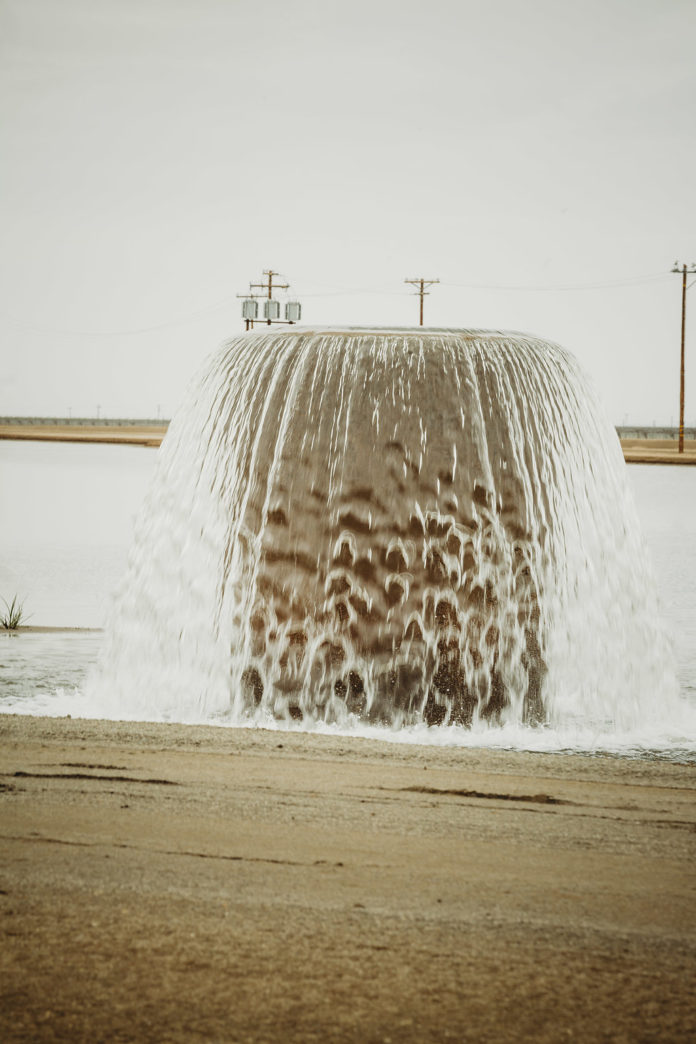 The Friant Water Authority board of directors met by teleconference on Thursday, May 28, 2020. The meeting began at 8:30am in closed session but went to open session at 9:30am. After Chairman Chris Tantau called the meeting to order and went through the public comment and the consent calendar approving the minutes and paying the bills the action items were discussed.
The Friant Water Authority board of directors met by teleconference on Thursday, May 28, 2020. The meeting began at 8:30am in closed session but went to open session at 9:30am. After Chairman Chris Tantau called the meeting to order and went through the public comment and the consent calendar approving the minutes and paying the bills the action items were discussed.
FWA CEO Jason Phillips presented the board with a plan to fund the necessary repairs on the Friant Kern Canal. The land underneath the FKC in a stretch near the Tulare Kern County line has dropped due to subsidence. This sinking has been big enough to diminish the canal’s capacity. The amount of money needed to restore the canal to design capacity has been estimated at $500 million or so.
The canal has to be fixed but how to pay for it is uncertain at this time. The greater the capacity the more expensive the repairs will be. Friant has already been through some valiant attempts at finding funding. A ballot initiative failed and that’s a story in itself. With the State of California’s government spending on COVID-19 there isn’t much expected to be left over for infrastructure and the feds commitment to funding is less than sure at this point. Friant contractors will have to figure out how to make up the difference. That most likely will be out of pocket. These contributions could vary. There are contractors upstream not being directly impacted by the kink in the canal. There are those in the subsidence area and there are those downstream who are in perhaps the most jeopardy of losing supplies due to limited ability of transporting water through the canal.
The funding options have been identified as existing in zones. Phillips said the proposed options have buy in from the US Bureau of Reclamation which is the agency that oversees the Central Valley Project which Friant is a part of. Zone Three is the additional capacity from repairs funded by Friant Contractors. Zone Two is the additional capacity from repairs funded by FWA, the public (taxpayer), Groundwater Sustainability Agencies involved in the sub basin where there subsidence is taking place and conveyance charges. Zone One is current capacity with no repairs and is expected to continue decreasing over time. There is also an ironic acronym F.O.G. FOG is the Friant Operating Guidelines. Zones One and Two will be operated by FOG. Zone Three is pay to play so to speak. The extra capacity providing by Zone Three funding will benefit those investing in Zone Three.
Staff’s recommendation for this item was for the board to approved continuing with developing a Zone Three formal agreement. The timeline is very aggressive. In order to start repairs on schedule the staff is asking for a response from the board by early next month. There will be a modeling session for the managers to participate in a few days.
Fresno ID’s Director George Porter asked about Reclamation contract deliveries and Phillips said that won’t change. Phillips also said the Bureau has been involved at a higher level than even the Regional Director Earnest Conant. This will also involve contractors who receive their CVP water from the FKC but are not FWA members. There was a great  deal of other detail discussed. Eric Quinley, GM Delano Earlimart ID said the modeling will answer a lot of the questions and provide the needed information to make a decision. The motion was made and seconded. The vote was by role call and a little out of the ordinary as comments were occasionally provided. Arvin Edison WSD Director Edwin Camp said, “Yes, deal of the century.” AEWSD is downstream. City of Fresno abstained and Fresno ID’s Porter voted no. They are both upstream. Madera ID voted yes and they are also upstream. The motion passed.
deal of other detail discussed. Eric Quinley, GM Delano Earlimart ID said the modeling will answer a lot of the questions and provide the needed information to make a decision. The motion was made and seconded. The vote was by role call and a little out of the ordinary as comments were occasionally provided. Arvin Edison WSD Director Edwin Camp said, “Yes, deal of the century.” AEWSD is downstream. City of Fresno abstained and Fresno ID’s Porter voted no. They are both upstream. Madera ID voted yes and they are also upstream. The motion passed.
Next COO Doug DeFlitch gave an update on the progress being made in preparing for FKC repairs. FWA is working with Stantec Engineering and the Bureau. There is a public  outreach EIR/EIS meeting on June 8th as it is now under public comment. DeFlitch said the land acquisition portion of the project is being run by the Bureau. The Army Corps of Engineers is working on other portions of the project such as the Deer Creek crossing. That’s kind of scary because I’ve been taught by Mr. Dick Schafer himself the average ACE nonmilitary project takes 20-years to complete. I believe this one may be high enough profile for the Army Corps to complete its portion of the task on time.
outreach EIR/EIS meeting on June 8th as it is now under public comment. DeFlitch said the land acquisition portion of the project is being run by the Bureau. The Army Corps of Engineers is working on other portions of the project such as the Deer Creek crossing. That’s kind of scary because I’ve been taught by Mr. Dick Schafer himself the average ACE nonmilitary project takes 20-years to complete. I believe this one may be high enough profile for the Army Corps to complete its portion of the task on time.
Phillips reported the FKC funding workshop in April was very successful and another one is tentatively scheduled for the end of June. He reported the cost sharing agreement with the Bureau is a fundamental part of the canal repair project. How much funding will the feds kick in and how much Friant contracts will have to repay is of great interest to the Bureau and the contractors. FWA’s External Affairs Officer Johnny Amaral said there is a chance to snag a specialized low interest loan next month. There is also a $200 million WIIN Act pot of money that could yield $50 million once the Zone Three and GSA contributions are worked out.
Attorney Don Davis and Phillips spoke about who will actually manage the construction. Phillips said whether the Bureau or FWA manages FWA will pay for it. Any work the Bureau does will be charged to Friant. He said there are pros and cons but in any event both FWA and the Bureau want the project to be smooth and efficient.
Davis ran into a little problem unmuting. I ran into a little problem myself earlier when I tried to join the teleconference. Clicking on the link caused a blank email to appear so I’ve been listening in on the phone. That was easy enough to do.
Davis’ voice appeared and he explained some of the types of bidding possible. If FWA is in charge or procuring the bidding process it can use the Lowest Responsible Bidder process and prequalify bidders who may not be big enough to secure full bonding could participate. If the Bureau procures the bid it uses the Best Value bidding process. The Lowest Bid process doesn’t apply until the project plans and specifications are 100 percent complete. If you go to the FWA website you can download a PDF that goes over this in greater detail including Davis’ written analysis of the different options.
The next item was the San Joaquin Valley Water Blueprint. Phillips started by thanking the board for its support in getting this project off the ground. Dr. Scott Hamilton is heading up the technical committee. His work is very innovative and I think holds to the key to some many of the challenges being faced such as domestic wells and white areas.
Hamilton also thanked Friant for its vision and this is what the Valley needs. He said the Blueprint has a disadvantaged communities and environmental benefit components. Restoring and recreating wildlife corridors in the Valley are part of the efforts. There is also a water quality/quantity component for the DACs. The current surface supply shortfall is 2 to 2.4 million a/f annually. There are huge outflows in the Delta, a minimum 10 million a/f annual average above and beyond the environmental regulatory needs. The trick is capturing the extra flow without harming the fish and habitat.
There is existing technology already in use in other parts of the country. Infiltration beds that allow the flows and fish and everything else to move freely from the river channels and back can divert the water through recharge. This is a natural process that doesn’t disturb a single hair on a fish’s head. On entrainment or reverse flows or other undesirable conditions will take place. The subsurface water would be collected and transferred to the pumping plants to move down the California Aqueduct and the Delta Mendota Canal. Studies show this is a very viable source of additional 2 million a/f of water and will not harm the environment and as you’ll see can actually help it.
This extra water will require more infrastructure and that will mean more conveyance. A couple of big canals will probably be needed to allow the new water supplies to get to the areas that most need this water. These areas include the white areas, the DACs and the wildlife refuges – see it does have enviro benefits that reach even further than the Delta. Of course all of this will require funding, permitting and construction. There will almost certainly be political opposition and most likely lawsuits. But the NGOs’ input is being solicited and it’s hoped the cooperation will be forthcoming. This isn’t an attempt to expand farmland, just to maintain what is being farmed. It will expand wildlife habitat using storm flows. That makes sense and should find some support in the enviro community.
Another mover and shaker in the Blueprint efforts is Austin Ewell. He said partly from efforts by Blueprint partner Fresno State and Friant the Leadership Counsel and Self Help Enterprises are looking at how this project can benefit the DACs. That’s encouraging.
Hamilton said this will come to the point of spending some money. Stantec is working up a cost estimate of implementing the Blueprint. Once this is in place the investment considerations, opportunities and benefits can be explored. Two proposed canals have been taken into consideration; the Trans Valley Canal and the Mid Valley Canal would be two important conveyance projects to flesh out this plan. Increased conveyance for the Madera Sub Basin needs to be looked at. Existing facilities are being included. The California Aqueduct could have capacity available after San Luis Reservoir fills to move some of this water.
After that breath of Blueprint fresh air Davis addressed the OM&R transfer agreement. This is the agreement between FWA and the Bureau for O&M costs. In the past 20-years there has only been one case of a small contractor coming close to being delinquent which was averted. Davis wisely I think used the discretion to not name the district and I couldn’t tell you who it was. But this issue is being worked out cooperatively for inclusion in the new long-term agreement.
Phillips spoke about the title transfer of the FKC from the Bureau to FWA. He said the Fresno USBR office’s band width hasn’t been big enough to push this to the top. There isn’t a real sense of urgency propelling momentum for this issue at this time.
Alex Biering Government Affairs & Communication Manage spoke saying the state’s  surplus is gone due to the coronavirus. She said it’s less likely to get state FKC funding but state Senator Melissia Hurtado is pushing for the state to kick in funds. This could involve some state sponsored stimulus money maybe in the billions of dollars from Sacramento (California taxpayers.) She was joined by consultant Mike Villines who said SB 559 will be heard next week but he doesn’t expect much as spending bills have been frozen. He said Hurtado has been working hard on this. Senator Diane Feinstein has a push going for more infrastructure money going to water projects like FKC repairs. This has been helpful. The state budget resolution is due next month and since the legislature’s paycheck is directly tied to passage it is expected to be signed on time. Water bonds are not expected to see the light of day this year.
surplus is gone due to the coronavirus. She said it’s less likely to get state FKC funding but state Senator Melissia Hurtado is pushing for the state to kick in funds. This could involve some state sponsored stimulus money maybe in the billions of dollars from Sacramento (California taxpayers.) She was joined by consultant Mike Villines who said SB 559 will be heard next week but he doesn’t expect much as spending bills have been frozen. He said Hurtado has been working hard on this. Senator Diane Feinstein has a push going for more infrastructure money going to water projects like FKC repairs. This has been helpful. The state budget resolution is due next month and since the legislature’s paycheck is directly tied to passage it is expected to be signed on time. Water bonds are not expected to see the light of day this year.
Amaral spoke saying some of the state’s proposed money comes from new fees, service cuts and federal money. I like at least one of these deficit fighting measures – I don’t think we need a Bureau of Home Furnishing in Sacramento. As for federal matters Amaral referred to Feinstein’s bill which is a companion bill to one in the House. He reminded folks once a bill to appropriate funds passed it still has to be authorized before money is released. Or maybe he said once a bill to authorize funds passes it still has to be appropriated. I don’t recall how this was covered in my long ago civics class.
FWA Water Resources Manager Ian Buck-Macleod gave his report saying this hot spell we’re going through has taken all but the highest elevation snow. There is a storm coming to Northern California this weekend, at least it’s forecast to do so. While the current, earlier than usual heat has accelerated snow melt and inflows it has helped with cold water pools. DWR will be providing another update next week. It’s unusual to get a snow report from the state this late in the year. The latest ASO flight data is still being figured and should be included in allocation forecasts soon. There’s a mid-June flight scheduled and it is clearly expected to show more snow loss.
Buck-Macleod reported on Delta operations saying spring X2 line control is impacting pumping. The legal fuss on the old and new biops is impacting things. If I understand correctly if the X2 line flows would not have been as great under operations of the old biops and would have yielded more export water than the new biops would. So the Incidental Take Permit came close to backfiring on its mission to starve exports. Careful what you wish for (again, if I understood correctly.) He reported so far there is no concern for the Bureau to take Friant water and send it to the Exchange Contractors.
There is only about 15 cfs of San Joaquin River Restoration Recapture Flows coming through Patterson ID. Consultant Steve Ottemoeller reported the restoration flow recapture may increase as Banta Carbona ID’s pumps are allowed to increase. It was difficult to hear him.
Buck-Macleod reported on the water quality policy for the FKC. There is the ability to pump non-SJR water into the canal which could impact the excellent water quality of the pure Sierra snowmelt. The further downstream the more pump in could take place and that impacts the contractors on the southern end of the canal more. Let’s say the salt load increases even a little bit, using this water for irrigation could cause salt build up on the soil.
David Brown Director from Orange Cove ID said the algae for the past couple of years has been a real problem for his district. Someone, I think DeFlitch said copper sulfate has been applied according to how much flow. This ratio has been the same for many years and so far Orange Cove has been the only problem spot. Tantau thanked him for bringing this up and it will be addressed.
Phillips gave his report saying the annual meeting scheduled for April was cancelled due to virus. As of now there isn’t any reschedule planned for that meeting. Too bad, I’ve always enjoyed it. Phillips said staff has benefited greatly from the board retreat and it is hoped this could be repeated this November after the elections.
Tantau said there may well be a live meeting next month as the state opens up. He did note this could have a great impact on not just travel time but personal hygiene and grooming. And that was that.
DISCLAIMER OF RESPONSIBILITY; Waterwrights strives to provide it’s clients with the most complete, up-to-date, and accurate information available. Nevertheless, Waterwrights does not serve as a guarantor of the accuracy or completeness of the information provided, and specifically disclaims any and all responsibility for information that is not accurate, up-to-date, or complete. Waterwrights’ clients therefore rely on the accuracy, completeness and timeliness of information from Waterwrights entirely at their own risk. The opinions expressed in this report are those of the author and do not represent any advertisers or third parties.
ALL RIGHTS RESERVED. Copyright 2020 by Don A. Wright
FRIANT WATER AUTHORITY
854 N. Harvard Ave., Lindsay, CA 93247, Office 559/562-6305 Email: information@friantwater.org www.friantwater.org
The Friant Water Authority is a Joint Powers Agreement with 15 districts to operate and maintain the Friant Division of the Central Valley Water Project. Water from the San Joaquin River is diverted at Friant Dam at Millerton Lake to the Madera/Chowchilla Canal to the north and the Friant/Kern Canal to the south. More than one million acres of mostly family farms and numerous communities get their surface supplies form the Friant Division.
Staff: CEO Jason Phillips, COO Doug DeFlitch, CFO Don Willard, Government Affairs & Communication Alexandra Biering, Water Resource Manager Ian Buck-Macleod, Superintendent Chris Hickernell and Attorney Don Davis.
































